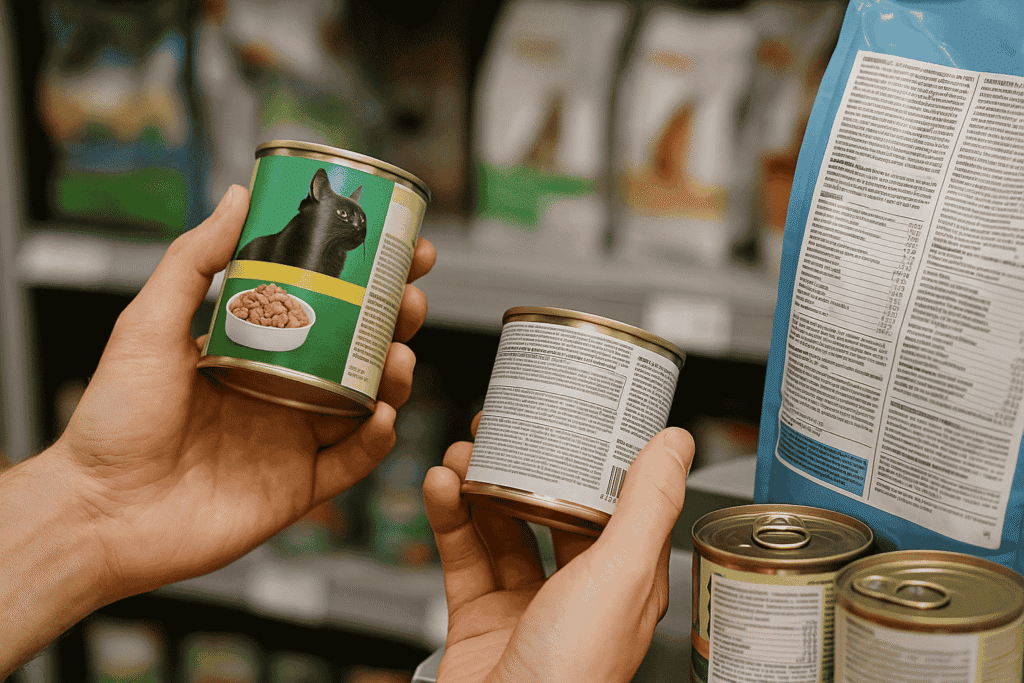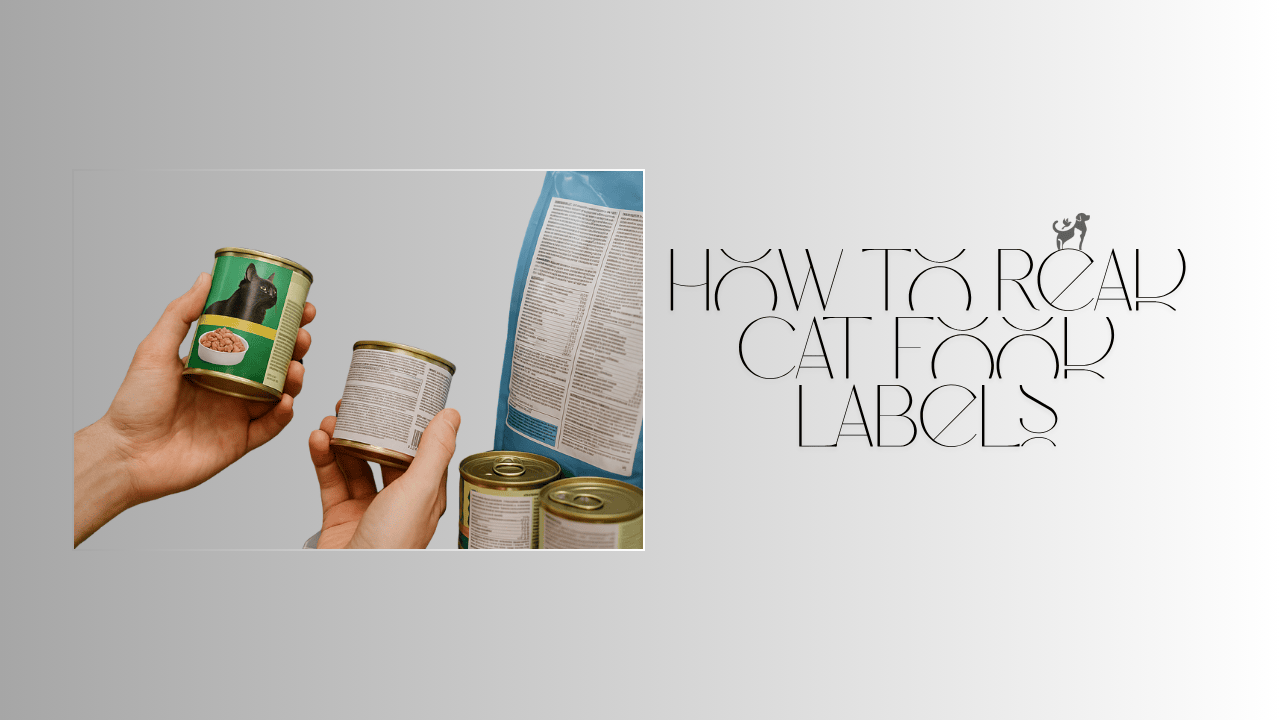Ever stood in the pet food aisle, staring at endless cans and bags of cat food wondering which one is actually good for your cat? You’re not alone. Understanding how to read cat food labels is crucial for making informed choices that support your cat’s health, especially with the overwhelming amount of marketing fluff and confusing ingredients. In this guide, we’ll break down every part of the label — from ingredients and feeding guidelines to sneaky marketing claims — so you can confidently pick the right food for your feline companion.

Why It’s Important to Understand Cat Food Labels
Cats are obligate carnivores, meaning their diet must be rich in animal-based proteins. Choosing the wrong food could lead to deficiencies, obesity, or digestive issues. By learning how to read cat food labels, you take control of your cat’s health and help them live a longer, happier life.
Unfortunately, not all cat food is created equal — even if it looks premium on the shelf.
What AAFCO Means and Why It Matters
Look for a statement on the packaging that says something like:
“This food is formulated to meet the nutritional levels established by the AAFCO Cat Food Nutrient Profiles…”
AAFCO (Association of American Feed Control Officials) doesn’t test or approve pet foods, but it provides nutrient standards manufacturers follow. Foods meeting AAFCO guidelines are more likely to offer complete and balanced nutrition.
According to PetMD, AAFCO guidelines are essential for ensuring nutritional adequacy.
Decoding the Ingredients List
Ingredients are listed by weight before cooking. This means that high-moisture items like chicken will appear first, even if the final protein content is lower after processing.
Look for:
- Named meats: “Chicken,” “salmon,” or “beef” is better than “meat by-products.”
- Avoid vague terms: Ingredients like “animal meal” or “poultry digest” are less transparent.
- Whole food sources: Brown rice or sweet potato is better than “grain by-products.”
- Limited fillers: Corn, wheat, soy, and artificial colors don’t add nutritional value.
Also, ingredients like taurine (essential for heart and eye health) should be included.
Guaranteed Analysis: What to Look For
This panel gives the minimum and maximum percentage of nutrients. It usually includes:
- Crude Protein
- Crude Fat
- Crude Fiber
- Moisture
But the challenge is comparing wet vs. dry food, since moisture content skews the numbers. To compare apples to apples, convert values to a dry matter basis.
You can learn more about this from ASPCA’s feeding guidelines.
Nutritional Adequacy Statement
You’ll typically see this near the guaranteed analysis. It tells you:
- If the food is complete and balanced
- Whether it’s for kittens, adults, or all life stages
- If the food was feeding trial-tested or just lab-formulated
Prefer foods that say:
“Animal feeding tests using AAFCO procedures substantiate that this product provides complete and balanced nutrition…”
That means real animals ate it, and it worked for them.
Marketing Tricks to Watch Out For
Food labels often use terms designed to appeal to you, not your cat. Here’s how to interpret them:
| Label Term | What It Usually Means |
|---|---|
| “Premium” | No legal definition, often just marketing |
| “Natural” | Minimal processing, but still vague |
| “Grain-Free” | Not always better — some cats need grains |
| “With Chicken” | Only needs 3% chicken to qualify |
| “Chicken Flavor” | May contain zero actual chicken |
Don’t be fooled by design — focus on the ingredient panel and AAFCO statement.
Wet vs Dry: Label Differences
Wet food usually contains 70–80% moisture. Dry kibble has around 10%. The ingredient order and guaranteed analysis look different because of that water content.
- Wet food may list “chicken” first — but that includes water weight.
- Dry food often starts with meals like “chicken meal,” which is more nutrient-dense.
Both can be part of a healthy diet. Choose based on your cat’s needs and your vet’s advice.
Common Misleading Terms and What They Mean
- “By-products”: Can include organ meats (which are good), but quality varies.
- “Meal”: Rendered meat concentrate. High in protein but depends on source.
- “No added sugar”: Pet foods rarely need sugar, so it’s a low bar.
- “Holistic”: No official definition.
Real Cat Parent Tip
When I first got Luna, my rescue tabby, I assumed all wet foods were equal. I didn’t realize some brands used “meat by-products” as the first ingredient. After switching to one with named proteins and no fillers, her coat got shinier and her digestion improved within two weeks.
Reading labels changed everything — and it’s why I now check every time before I buy.
FAQ
What’s the most important thing to check on a cat food label?
Start with the first three ingredients, the AAFCO statement, and whether it’s complete and balanced for your cat’s life stage.
Is grain-free cat food better?
Not always. Grain-free doesn’t mean healthier. Some cats tolerate grains well and benefit from the fiber.
Should I choose food with by-products?
It depends. By-products can include organ meats, which are nutritious. But lower-quality by-products may not offer the same benefits.
What does “human-grade” mean?
It’s not regulated in pet food labeling. Just because it says “human-grade” doesn’t mean it meets those standards throughout production.
How can I compare wet and dry food?
Convert nutrients to a dry matter basis to fairly compare the protein and fat content.
Final Thoughts
Learning how to read cat food labels puts the power in your hands. With so many misleading claims and confusing terms, it’s easy to be swayed by branding. But by focusing on the ingredients, guaranteed analysis, and AAFCO standards, you’ll make choices that truly benefit your cat’s health.
Your cat depends on you to read beyond the marketing — and now you can.
Call-to-Action
Found this helpful? Share it with a fellow cat parent, or check out fluffze.com for more feline health tips, like homemade fish cat treats and how to brush your cat’s teeth without stress.
Written by Author Box
Written by Shawn, pet lover & contributor at Fluffze
Related Articles:
UTI in Cats Home Remedy: Safe, Natural Solutions
Safe Flea Treatment for Puppies Under 12 Weeks
The Best Homemade Cat Food for Sensitive Stomach
Best Homemade Cat Food for Kidney Disease
Best Homemade Dog Food for Sensitive Stomach





